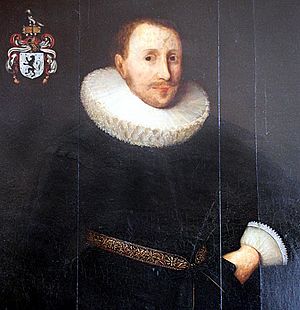John Kendrick (cloth merchant) facts for kids
Quick facts for kids
John Kendrick
|
|
|---|---|

"Founder of this worke house"
With permission from Mrs Elms, previous Head of Kendrick School |
|
| Born | 1573 |
| Died | 30 December 1624 (aged 51) |
| Resting place | St Christopher le Stocks Church, London; Nunhead Cemetery |
| Occupation | Cloth merchant |
| Known for | Founder of Kendrick Boys' School (benefactor of Reading School); Founder of Kendrick Girls' School |
| Parent(s) | Thomas Kendrick & Agnes Bye |
| Relatives | John Kendrick, Lord Mayor of London (1651) |
John Kendrick (1573 – 30 December 1624) was a very successful English cloth merchant. He was also a generous supporter of the towns of Reading and Newbury in Berkshire.
Contents
The Life of John Kendrick
John Kendrick was born in Reading, Berkshire, in 1573. His father, Thomas Kendrick, was an important citizen and a weaving merchant who later became the mayor of Reading.
Early Life and Education
John was baptised on 18 May 1574 at St Mary's Church in Reading. He went to Reading School and then studied at St John's College, Oxford.
Becoming a Wealthy Merchant
After finishing university, John Kendrick moved to London. There, he became very rich by trading cloth with the Netherlands. He was a successful businessman.
His Final Years
John Kendrick passed away on 30 December 1624 at his home in Threadneedle Street, London. He was first buried at St Christopher le Stocks Church. Later, his remains were moved to Nunhead Cemetery.
John Kendrick's Lasting Legacy
In his will, John Kendrick left a large sum of money, £12,500, to the towns of Reading and Newbury. He wanted this money to help create jobs and provide education for people who were poor.
Helping Reading: The Oracle Workhouse
With some of Kendrick's money, a building called the Oracle workhouse was built in Minster Street, Reading. A workhouse was a place where people who were poor could find work and shelter. Today, a big shopping centre called The Oracle stands on part of this old site.
Founding Schools in Reading
Even though some of the money was not managed well, enough was left to start two important schools:
- Kendrick Boys School was founded in 1875.
- Kendrick Girls School was founded in 1877.
In 1915, Kendrick Boys School became part of Reading School. Today, a building at Reading School is named the John Kendrick Building in his honour. An old painting of John Kendrick, which was saved from the Oracle workhouse, hangs in the main hall of Kendrick School (the girls' school). The painting's caption says, "John Kendrick, founder of this worke house."
Supporting Newbury: The Cloth Hall
Kendrick also left £4,000 to the town of Newbury. This money was used to build a 'cloth manufactory'. This was a place where unemployed cloth workers could find jobs and make cloth. The idea was to help the town's cloth trade recover.
However, the cloth trade in Newbury never fully recovered. The building was used for many different things over the years, like a workhouse, a hospital, and even a school. In 1903, it was restored and became the Newbury Borough Museum. It is now known as the Cloth Hall and is part of the West Berkshire Museum. Kendrick's money also helped fund a charity that offered education and apprenticeships to poor children in Newbury.


